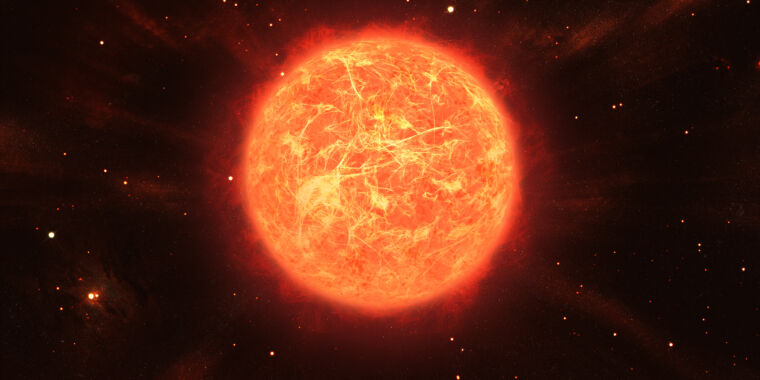Garching / Jülich / Greifswald – For more than 70 years, physicists have dreamed of generating energy based on the principle of the Sun. With nuclear fusion, huge amounts of energy can be produced – in a climate-neutral manner without emitting greenhouse gases. However, nuclear fusion reactors hardly ever play a role in the debate about future energy sources. Experts say, incorrectly, referring to technical developments.
While nuclear energy generates energy by splitting atomic nuclei, producing radioactive waste and carrying the risk of serious accidents, nuclear fusion generates energy by fusing small atomic nuclei into larger ones. Since it requires extremely high temperatures, this technology is harmless to the environment, its proponents say: in the event of a malfunction, the temperature drops and the reaction stops.
dpa
View inside the JET reactor in Culham, UK. In 1991, a solar fire first lit in a controlled manner on Earth.
30 years ago, in November 1991, scientists in Culham near Oxford, England for the first time succeeded in generating an even greater amount of power through nuclear fusion: 1.8 megawatts – but for only two seconds. To date, the nuclear fusion reaction has never recovered more than 70 percent of the amount of energy supplied. But physicist Hartmut Zum is convinced that large amounts of energy can be generated using nuclear fusion. Zoom heads the tokamak scenario development department at the Max Planck Institute for Plasma Physics (IPP) in Garching near Munich.
Temperatures of up to 150 million degrees prevail in the center of the plasma
Plasma physics is the name of the field in which fusion reactor technology is being developed. Because the substance in the reactor, the “fuel,” is in the form of plasma. In this superheated gas, the charge carriers in the atom and the positively charged protons and negatively charged electrons are separated from each other. Therefore, plasma is electrically conductive and can be kept suspended in a ring-shaped reactor by an extremely strong magnetic field.
This is also necessary, since good thermal insulation is necessary for the desired temperatures of more than 100 million degrees Celsius. This cannot be achieved by contact with the walls of the cold vessel. In the center of the plasma is about 150 million degrees – ten times the temperature at the center of the Sun.

IPP / ixtract
Schematic representation of the Wendelstein 7-X system. You can see the plasma vessel with twisted plasma, magnetic coils including cable and cooling lines as well as parts of the fusion system’s outer shell.
“In a nuclear fusion reactor, we use a different kind of nuclear fusion than what happens in the sun,” explains Zoom. Because of the enormous pressure inside the star, “only” 15 million degrees is enough for a proton and a proton to fuse through several stages until the final product helium (He). In the fusion reactor, the hydrogen isotopes deuterium (2H) and tritium (3H) are combined at a particle density corresponding to one part per million of air, and helium is also produced here. Deuterium and tritium are also called very heavy and heavy hydrogen.
The fusion reaction produces free neutrons with a large amount of energy. In a fusion power plant, they are supposed to heat water so that steam can power turbines – just like in other power plants. But there are still many technical obstacles to overcome, because the plasma cannot be kept in the magnetic field so easily. To do this, the magnetic field in the reactor must be wound in a helical fashion.

dpa / IPP / Jan Michael Hosan
View in plasma of Wendelstein 7-X.
There are two concepts for this: in the tokamak principle, the external magnetic field is generated by coils of simple geometry. The strong electric current flowing in the plasma ensures torsion. With the star principle, on the other hand, no current flows in the plasma, but the twisted magnetic field generating coils have very complex and twisted shapes.
“The stellarator has a number of properties that are useful for long-term power plant operation,” says Thomas Klinger. He is the scientific director of the Wendelstein 7-X stellarator facility at the IPP site in Greifswald. The facility has been used for experiments since 2015. Its magnetic coils are cooled to minus 270 degrees with liquid helium and are superconducting – electric current can flow without resistance.
Concepts appeared in East and West about 70 years ago
In a tokamak reactor, on the other hand, pulses must be used due to the current in the plasma; In the phases between them there is cooling. “Engineers don’t like cycles like this because they put a lot of stress on the material,” Klinger emphasizes. On the other hand, the Stellarator can run for a long time without interruption, provided that all the conditions of the framework are correct.
The concepts of tokamak and stellarator appeared at the same time – about 70 years ago – in different parts of the world. The twisted magnetic field was easier to implement with the tokamak principle. Until the late 1980s, computations using supercomputers paved the way for modern, improved star instruments with their complex magnetic coils. However, the world’s largest experimental reactor for nuclear fusion, ITER (International Thermonuclear Experimental Reactor) is still under construction in southern France, which will be operated under the tokamak concept. The first planning draft for ITER dates back to 1990 – and came from Garching, among others.
The first plasma will be produced in the reactor in December 2025
According to preliminary estimates, the reactor is supposed to cost about five billion euros, but experts now assume that its cost will be three times higher. In the period from 2021 to 2027, the European Union contributes about 5.6 billion euros. The European Union, the United States, Russia, China, India, Japan and South Korea are participating in ITER. “They represent more than half of the world’s population,” says Zoom. However, it is sometimes difficult to make decisions. According to current plans, the reactor’s first plasma is scheduled for December 2025. Zohm firmly believes that ITER can show that a nuclear fusion reactor can provide ten times the energy it takes to heat the plasma.
Christian Linsmeyer thinks so, too, as the director of the Institute for Energy and Climate Research at Forschungszentrum Jülich is working on materials for fusion reactors — for example for reactor vessel coatings. The ASDEX Upgrade research facility, which operates in the Zohm-led research area in Garching, is lined with tungsten – the chemical element with the highest melting temperature of more than 3,400°C.
Because ultrashort plasma bursts can also damage this metal, Linsmeier and colleagues developed a tungsten-fiber-reinforced tungsten block: the small cavities in a tungsten-fiber braid in turn filled with tungsten. Linsmeier explains that this construction stops the formation of cracks. “When a fault generated by the plasma strikes the fiber interface, its energy is distributed and the faulting stops.” An additional step is to prevent widespread oxidation if air enters the reactor vessel. An alloy of tungsten, about 11 percent chromium and less than one percent yttrium, ensures the formation of a thin oxide layer when in contact with air, which prevents further oxidation.
The first power plant only in the second half of the century
Despite all the challenges, Linsmeyer is sure that the problems that still remain can be overcome: “We have a very broad understanding of plasma physics, and technical development has come a long way.” Thomas Klinger of Wendelstein 7-X also thinks nuclear power is fusion ready for use. When asked if someone has donated a lot of money to technology, he spontaneously said, “Then we can start with the next step!”
The researchers estimated about 30 billion euros for such an experimental power plant, which – unlike a research reactor – would power the power grid. According to Eurofusion, a nuclear fusion reactor of the future could generate one to two gigawatts of electricity – roughly equivalent to the production of a nuclear power plant.
But there are also doubts. Some argue that the technical challenge is too great. Others think the technology is too late. In order to take a step towards continuous operation, the fusion-related plasma should not be generated for just a few seconds, as before, but for half an hour. Technically and physically there is a world in between, says Thomas Klinger of Wendelstein 7-X in Greifswald. However, it’s not far from half an hour for real continuous work. For longer operation, 600 water-cooled circuits were recently installed.
Klinger expects to build its first power plant in the second half of this century. In hindsight, Claudia Kimfert thinks. “Now we need solutions to protect the climate,” stresses the energy expert from the German Economic Institute. “Many studies rightly indicate that the future lies in renewable energies.”
Critics call nuclear fusion a “fraudulent sign”
Can one be beyond that? “Absolutely,” says Thomas Klinger. “The reason is simply that nothing has been done or not much has been done.” There were other priorities. Power hasn’t been an issue for a long time. “There was enough oil and gas.” Nuclear fission is due to his advances to the military. Existing reactors are actually enlarged submarine reactors. “Fortunately, the research has survived,” says Klinger, referring to nuclear fusion.
“I’m glad that nothing else has been put into nuclear fusion,” says Heinz Smital, a nuclear expert from Greenpeace. This is certainly very exciting basic research, but it really has nothing to do with power supplies. He talks about “fraudulent labeling”. A similar statement was made by the Green Member of the Bundestag and former Environment Minister Stefan Wenzel: “In the fight against the climate crisis, nuclear fusion comes decades late, if ever it succeeds.”
According to Thomas Klinger, nuclear fusion would be at least safer than nuclear fission. Even if terrorists, for example, aimed a plane directly into the combustion chamber, much less short-lived radioactive material would be released than with nuclear fission. There are no highly radioactive fission products that must be stored for tens of thousands of years. The steel in the components becomes radioactive, but can be reused after 50 to 150 years. In addition, a chain reaction is not possible. Nuclear fusion is compared to a candle that simply goes out if something goes wrong.
Klinger warns that nuclear fusion will stop. “You will be happy with every choice.” Renewable energies will play a very important role in the future. But whether it will be able to satisfy humanity’s growing hunger for energy in the long term is not guaranteed. Nuclear fusion will be of particular interest to the selective supply of megacities in the future. “There are only five or six big power plants around – calm in the box.” They can also offset fluctuations. (dpa/ft)

“Certified tv guru. Reader. Professional writer. Avid introvert. Extreme pop culture buff.”







More Stories
Holodeck: Star Trek technology becomes reality
New technology revolutionizes hurricane forecasting :: wetter.at
SBB replaces railway radio technology between Thun and Bern